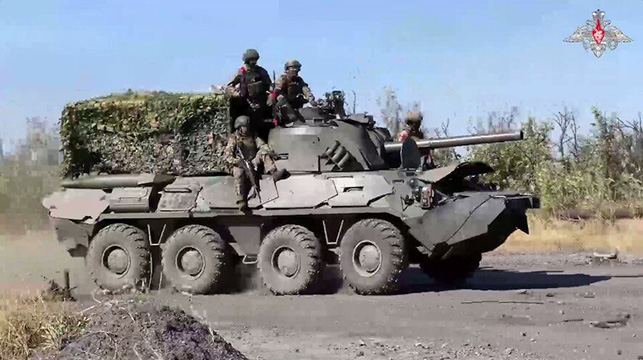 Russian forces
Russian forces
Photo: Russian MoD
In public, Mr Austin America’s defence secretary, offered certitude, confidence and clarity: “Moscow will never prevail in Ukraine.” In private, his colleagues in the Pentagon, Western officials and many Ukrainian commanders are increasingly concerned about the direction of the war and Ukraine’s ability to hold back Russian advances over the next six months, writes ‘The Economist’.
Ukrainian forces have managed to hold on to Pokrovsk. But elsewhere along the front, Russia is slicing its way through Ukrainian defences. In Kupiansk in the north, its troops have cut Ukrainian formations in two at the Oskil river. In Chasiv Yar in the east, they have crossed the main Siverskyi Donets canal. Farther south, Russian troops have taken high ground in and around Vuhledar, and are moving in on Kurakhove from two directions. In Kursk, inside Russia, Ukraine has lost around half the territory it seized earlier this year.
Ukrainian units are understrength and overstretched, worn thin by heavy casualties. Despite a new mobilisation law that took effect in May, the army, outside a handful of brigades, has struggled to recruit enough replacements, with young men reluctant to sign up to tours of duty that are at best indefinite and, at worst, one-way missions. Western partners are privately urging Ukraine’s leaders to lower the mobilisation age floor from 25 to increase the potential pool of recruits. But political sensitivities and fears over an already alarming demographic crisis stand in the way of any change.
In a recent essay, Jack Watling of the Royal United Services Institute, a think-tank in London, identifies several reasons for Ukraine’s declining fortunes. One is a shortfall in its air-defence interceptors, allowing Russian reconnaissance drones to establish what he calls “continuous and dense surveillance”. These in turn cue up ballistic-missile and drone strikes against Ukrainian artillery in the rear and glide bombs against troops at the front, allowing Russia to make slow but steady advances in small units, often using motorcycles because tanks are too easy to spot.
Ukraine’s limited stock of shells — Russia currently has a two-to-one advantage in shellfire, according to Ivan Havrilyuk, Ukraine’s deputy defence minister — as well as tanks and armoured vehicles compounds that problem. The less firepower and armour are available, the greater the reliance on infantry and the greater the casualties.
The gloomy mood is evident in a shift in America’s language. Senior officials like Mr Austin still strike a confident note, promising that Ukraine will win. Those involved in the guts of planning in the Pentagon say that, in practice, the ambitions of early 2023 — a Ukrainian force that could take back its territory or shock Russia into talks through a well-crafted armoured punch — have given way to a narrow focus on preventing defeat. “At this point we are thinking more and more about how Ukraine can survive,” says a person involved in that planning. Others put it more delicately.
“The next several months,” noted Jim O’Brien, the State Department’s top Europe official, at a conference in Riga on October 19th, “are an opportunity for us to reaffirm that Ukraine can stay on the battlefield for the next couple of years.”
read more in our Telegram-channel https://t.me/The_International_Affairs

 12:24 01.11.2024 •
12:24 01.11.2024 •






















